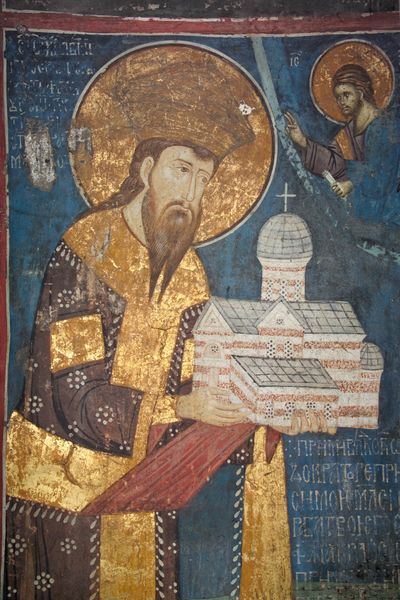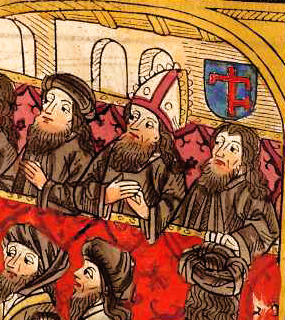|
Visoki Dečani
The Visoki Dečani Monastery ( sr, Манастир Високи Дечани, Manastir Visoki Dečani, sq, Manastiri i Deçanit) is a medieval Serbian Orthodox Christian monastery located near Deçan, Kosovo. It was founded in the first half of the 14th century by Stefan Dečanski, King of Serbia. The Visoki Dečani monastery is located by the Deçan's Lumbardh river gorge at the foot of the Accursed Mountains, in the region of Metohija. It is located about from the town of Deçan. The monastery is managed by the Serbian Orthodox Eparchy of Raška and Prizren. The monastery has been under the legal protection of Serbia since 1947 with a designation of ''Cultural Monument of Exceptional Importance''. The monastery is part of the World Heritage site named " Medieval Monuments in Kosovo". History Construction began during the reign of Serbian King Stefan Dečanski in 1327 and the original founding charter from 1330 has been preserved. Dečanski's son, Stefan Dušan, seized the ... [...More Info...] [...Related Items...] OR: [Wikipedia] [Google] [Baidu] |
Serbian Orthodox
The Serbian Orthodox Church ( sr-Cyrl, Српска православна црква, Srpska pravoslavna crkva) is one of the autocephalous (ecclesiastically independent) Eastern Orthodox Christian churches. The majority of the population in Serbia, Montenegro and the Republika Srpska entity of Bosnia and Herzegovina are members of the Serbian Orthodox Church. It is organized into metropolitanates and eparchies, located primarily in Serbia, Bosnia and Herzegovina, Montenegro, and Croatia. Other congregations are located in the Serb diaspora. The Serbian Patriarch serves as first among equals in his church. The current patriarch is Porfirije, enthroned on 19 February 2021. The Church achieved autocephalous status in 1219, under the leadership of Saint Sava, becoming the independent Archbishopric of Žiča. Its status was elevated to that of a patriarchate in 1346, and was known afterwards as the Serbian Patriarchate of Peć. This patriarchate was abolished by the Ottoman Em ... [...More Info...] [...Related Items...] OR: [Wikipedia] [Google] [Baidu] |
Metohija
Metohija ( sr-Cyrl, Метохија, ) or Dukagjin ( sq, Rrafshi i Dukagjinit, ) is a large basin and the name of the region covering the southwestern part of Kosovo. The region covers 35% (3,891 km2) of Kosovo's total area. According to the 2011 census, the population of the region is 700,577. Districts It encompasses three of the seven districts of Kosovo: Names The name ''Metohija'' derives from the Greek word (''metóchia''; singular , '' metóchion''), meaning "monastic estates" – a reference to the large number of villages and estates in the region that were owned by the Serbian Orthodox monasteries and Mount Athos during the Middle Ages. In Albanian the area is called ''Rrafshi i Dukagjinit'' and means "the plateau of Dukagjin", as the toponym (in Albanian) took the name of the Dukagjini family who ruled a large part of Metohija during the 14th-15th centuries, hence the name. The term "Kosovo and Metohija" ( sr-cyr, Косово и Мето ... [...More Info...] [...Related Items...] OR: [Wikipedia] [Google] [Baidu] |
Great Feasts Of The Orthodox Church
In the Eastern Orthodox Church, the feast of the Resurrection of Jesus, called Easter, Pascha (Easter), is the greatest of all holy days and as such it is called the "feast of feasts". Immediately below it in importance, there is a group of Twelve Great Feasts (Greek: Δωδεκάορτον). Together with Pascha, these are the most significant dates on the Orthodox liturgical calendar. Eight of the great feasts are in honor of Jesus, Jesus Christ, while the other four are dedicated to the Blessed Virgin Mary, Virgin Mary — the Theotokos. The Twelve Great Feasts are as follows (note that the liturgical year begins with the month of September): #The Nativity of the Theotokos, #The Exaltation of the Cross, #The Presentation of the Theotokos, #The Nativity of Christ (Christmas), #The Baptism of Christ (Theophany, also called Epiphany (Christian), Epiphany), #The Presentation of Jesus at the Temple (Candlemas), #The Annunciation, #The Entry into Jerusalem (Flowery/Willow/Palm ... [...More Info...] [...Related Items...] OR: [Wikipedia] [Google] [Baidu] |
Gregory Tsamblak
Gregory Tsamblak or Grigorij Camblak ( bg, Григорий Цамблак, sr-Cyr, Григорије Цамблак; c. 1365–1420) was a Bulgarian writer and cleric. He was the pretended Metropolitan of Lithuania between 1413 and 1420. A Bulgarian noble, Tsamblak lived and worked in Bulgaria, but also in Medieval Serbia and Kievan Rus'. His literary works represent a heritage of the national literature of Serbia, particularly the style of Old Serbian ''Vita'' made popular in the monasteries of the 12th century. Life He was born in Tarnovo, the capital of the Second Bulgarian Empire, the son of a rich family. His cousin was Cyprian, Metropolitan of Kiev. Tsamblak was a disciple of the prominent Bulgarian hesychast writer Patriarch Evtimiy of Bulgaria. Bulgaria fell under Ottoman domination following the Bulgarian-Ottoman Wars. Following this, he emigrated first to Constantinople, then became presbyter of the Church of Wallachia and Moldavia. He then went to Serbia where he wa ... [...More Info...] [...Related Items...] OR: [Wikipedia] [Google] [Baidu] |
Ana-Neda
Ana-Neda (Bulgarian and sr-cyr, Ана-Неда; fl. 1323–1324) was the Empress consort of Bulgaria briefly in 1323–1324 as the spouse of "Despot of Vidin" Michael Shishman who was elected as Emperor of Bulgaria in 1323. She was the daughter of Serbian King Stefan Uroš II Milutin and Princess Elizabeth Arpad, daughter of King Stephen V of Hungary and Elizabeth the Kumana daughter of Köten. From the marriage with Michael, they had three sons, one of whom was Ivan Stephen of Bulgaria, later briefly the Emperor of Bulgaria (1330–1331). Life She was the daughter of Serbian King Stefan Uroš II Milutin and Princess Ana Terter, daughter of George I of Bulgaria. Some believe that her mother was Elizabeth of Hungary. From the marriage with Michael they had three sons: *Ivan Stephen of Bulgaria, emperor of Bulgaria in 1330-1331 *Michael, ''despotes'' in Vidin for a brief period * Shishman, pretender to the Bulgarian throne In 1324, Michael Shishman divorced Anna Neda in or ... [...More Info...] [...Related Items...] OR: [Wikipedia] [Google] [Baidu] |
Manastirica (Prizren)
Manastirica ( sr-cyr, Манастирица; sq, Manastiricë; bs, Manastirica) is a village in the Prizren Municipality in southern Kosovo, close to the border between Kosovo and North Macedonia. History The village of Manastirica was settled by construction workers who took part in the construction of the Visoki Dečani Monastery in the early 1300s. As a sign of gratitude for their work, these workers were gifted the village of Manastirica to settle by the Serbian king Stefan Dečanski following completion of the build. Demographics The village is almost exclusively inhabited by Bosniaks The Bosniaks ( bs, Bošnjaci, Cyrillic: Бошњаци, ; , ) are a South Slavic ethnic group native to the Southeast European historical region of Bosnia, which is today part of Bosnia and Herzegovina, who share a common Bosnian ancestry .... Notes and references Notes: References: * Villages in Prizren {{Kosovo-geo-stub ... [...More Info...] [...Related Items...] OR: [Wikipedia] [Google] [Baidu] |
Prizren
) , settlement_type = Municipality and city , image_skyline = Prizren Collage.jpg , imagesize = 290px , image_caption = View of Prizren , image_alt = View of Prizren , image_flag = , flag_alt = Flag of Prizren , image_seal = , seal_alt = Seal of Prizren , pushpin_map = Kosovo , pushpin_map_alt = Location of Prizren in Kosovo and Europe , pushpin_mapsize = 290 , pushpin_relief = 1 , pushpin_label = Prizren , coordinates = , subdivision_type = Country , subdivision_name = , subdivision_type2 = District , subdivision_name2 = Prizren , established_title = , established_date = , government_type = Mayor–council , leader_party = PDK , leader_title = Mayor , leader_name = Shaqir Tot ... [...More Info...] [...Related Items...] OR: [Wikipedia] [Google] [Baidu] |
Hegumen
Hegumen, hegumenos, or igumen ( el, ἡγούμενος, trans. ), is the title for the head of a monastery in the Eastern Orthodox and Eastern Catholic Churches, similar to the title of abbot. The head of a convent of nuns is called a hegumenia or igumeni ( el, ἡγουμένη). The term means "the one who is in charge", "the leader" in Greek. Overview Initially the title was applied to the head of any monastery. After 1874, when the Russian monasteries were reformed and classified into three classes, the title of ''hegumen'' was reserved only for the lowest, third class. The head of a monastery of the second or first class holds the rank of archimandrite. In the Greek Catholic Church, the head of all monasteries in a certain territory is called the ''protohegumen''. The duties of both hegumen and archimandrite are the same, archimandrite being considered the senior dignity of the two. In the Russian Orthodox Church the title of Hegumen may be granted as an honorary title to ... [...More Info...] [...Related Items...] OR: [Wikipedia] [Google] [Baidu] |
Romanesque Architecture
Romanesque architecture is an architectural style of medieval Europe characterized by semi-circular arches. There is no consensus for the beginning date of the Romanesque style, with proposals ranging from the 6th to the 11th century, this later date being the most commonly held. In the 12th century it developed into the Gothic style, marked by pointed arches. Examples of Romanesque architecture can be found across the continent, making it the first pan-European architectural style since Imperial Roman architecture. The Romanesque style in England and Sicily is traditionally referred to as Norman architecture. Combining features of ancient Roman and Byzantine buildings and other local traditions, Romanesque architecture is known by its massive quality, thick walls, round arches, sturdy pillars, barrel vaults, large towers and decorative arcading. Each building has clearly defined forms, frequently of very regular, symmetrical plan; the overall appearance is one of simplic ... [...More Info...] [...Related Items...] OR: [Wikipedia] [Google] [Baidu] |
Albanians
The Albanians (; sq, Shqiptarët ) are an ethnic group and nation native to the Balkan Peninsula who share a common Albanian ancestry, culture, history and language. They primarily live in Albania, Kosovo, North Macedonia, Montenegro, Serbia as well as in Croatia, Greece, Italy and Turkey. They also constitute a large diaspora with several communities established across Europe, the Americas and Oceania. Albanians have Paleo-Balkanic origins. Exclusively attributing these origins to the Illyrians, Thracians or other Paleo-Balkan people is still a matter of debate among historians and ethnologists. The first certain reference to Albanians as an ethnic group comes from 11th century chronicler Michael Attaleiates who describes them as living in the theme of Dyrrhachium. The Shkumbin River roughly demarcates the Albanian language between Gheg and Tosk dialects. Christianity in Albania was under the jurisdiction of the Bishop of Rome until the 8th century AD. Then, dioceses ... [...More Info...] [...Related Items...] OR: [Wikipedia] [Google] [Baidu] |
Vlachs
"Vlach" ( or ), also "Wallachian" (and many other variants), is a historical term and exonym used from the Middle Ages until the Modern Era to designate mainly Romanians but also Aromanians, Megleno-Romanians, Istro-Romanians and other Eastern Romance-speaking subgroups of Central and Eastern Europe. As a contemporary term, in the English language, the Vlachs are the Balkan Romance-speaking peoples who live south of the Danube in what are now southern Albania, Bulgaria, northern Greece, North Macedonia, and eastern Serbia as native ethnic groups, such as the Aromanians, Megleno-Romanians and the Timok Romanians. The term also became a synonym in the Balkans for the social category of shepherds, and was also used for non-Romance-speaking peoples, in recent times in the western Balkans derogatively. The term is also used to refer to the ethnographic group of Moravian Vlachs who speak a Slavic language but originate from Romanians. "Vlachs" were initially identified and des ... [...More Info...] [...Related Items...] OR: [Wikipedia] [Google] [Baidu] |





